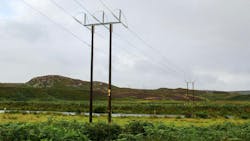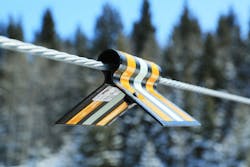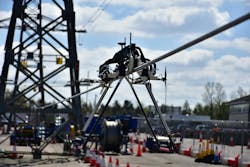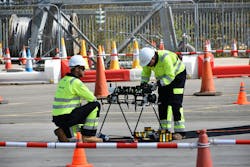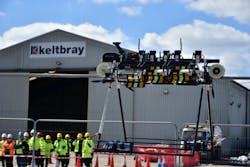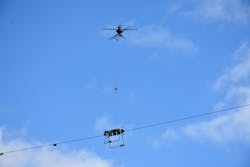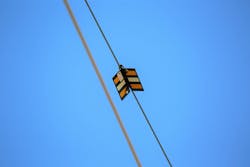A More Bird-Friendly Sky: Robots and UAVs Install Bird Diverters
Keeping animal life and transmission and distribution equipment separate is in everyone’s best interest, from the engineers and electricity customers to the animals themselves.
Scottish & Southern Electricity Networks (SSEN) Transmission, which is responsible for the transmission grid in the northern parts of Scotland, maintains a network of 132kV, 220kV, 275kV and 400kV transmission lines as well as underground and subsea cables and associated substations. SSEN Transmission works closely with National Grid ESO, which operates Great Britain’s power grid.
Producing more than 9 GW of renewables and another 40 GW planned, Scotland is a net exporter of renewable energy and a green power laboratory of sorts, with offshore wind as well as wave and tidal generators being tested off Scotland’s shores. About two-thirds of the power generated in SSEN Transmission’s network is transmitted to load centers in the south. Operating as a natural monopoly, SSEN Transmission is regulated by the Office of Gas and Electricity Markets, or Ofgem, which has the power to decide how much revenue SSEN is allowed to take in and invest in boosting the power grid.
Protecting Birds and Grids
And with the goal of net zero carbon by 2030, SSEN Transmission has a twin responsibility: To keep power lines safe from animals and vice versa. Birds are a particularly major concern due to the substantial risks they pose to the grid, from hazardous nesting to unsafe perching to fatal power line collisions.
In 2022 at its Alyth Substation, the grid operator built nesting platforms for a mated pair of ospreys migrating from Africa. This operation was a success as the raptors were able to mate, hatch and raise healthy chicks, each of whom made the trip back south. The raptors have since been spotted roosting atop one of SSEN Transmissions 48-meter high transmission pylons during a regular maintenance check. By providing them with an alternate nesting space, SSEN prevented contact between birds and T&D equipment that neither the birds nor the power grid would have benefitted from. This is one way to divert birds away from potentially hazardous power equipment.
Additionally, as this net zero carbon goal nears and the need for additional powerlines through sensitive avian habitat increases, SSEN has set a new target to install the bird flight diverter with the most contrasting shape and design in order to enhance visibility and prevent fatal collisions.
Diverting Birds Safely
Another way to keep birds and T&D equipment safe from one another is to provide a visual warning that allows a bird to alter its flight path and avoid danger. Birds often find power lines an attractive place to perch or an obstacle to their flight paths. Keeping birds and power lines separate is in everyone’s best interest. Bird flight diverters are simple devices that can give birds a visual cue to avoid power lines by making the lines more visually conspicuous.
In a search for the highest contrasting diverter, SSEN Transmission found Colorado-based Power Line Sentry, a wildlife mitigation firm, who worked with bird ophthalmologists to develop today’s Hawk Eye BFD. This diverter is unique among marker options with its high visibility features. The Hawk Eye has an A-frame tent shape, contrasting prismatic colors and 24-hour rated glow in the dark bands, it offers a movement effect without mechanical components or line slippage, it provides low wind and ice loads, and is rated for systems up to 345kV with no corona, and it can be safely installed with the FulcrumAir LineFly robot. All vital characteristics for diverting birds away from powerlines, and for a safe and efficient installation.
Working together with SSEN Trans-mission, FulcrumAir and Power Line Sentry’s technology made the bird diversion concept work.
FulcrumAir creates and manufactures unique drones and robots and in 2020 they designed the LineFly to install North America’s favored diverter: the Power Line Sentry Hawk Eye BFD. The installation process is straightforward, safe and efficient: their powerful heavy-lift E2500 drone lifts the LineFly robot, stocked with Hawk Eye BFDs, onto the line and installs full spans of the BFDs in sequence, automatically, while being controlled by FulcrumAir’s operators from the ground.
Safety and Efficiency
SSEN Transmission had the goal to combine effective avian protection, safe installation, and no network downtime. The combined robot and drone solution practiced by FulcrumAir and Power Line Sentry met all three of these requirements. The LineFly robot places full spans of Hawk Eye bird flight diverters in about a minute and a half, and can operate on ground or shield wires with transmission lines energized, or directly on energized distribution lines.
More orthodox methods of placing diverters on lines would use elevated work platforms and line workers with hot sticks — thus introducing safety risks. Drones and robots can do their work without requiring any people to work at height. This opens up maintenance crews to larger time windows, more access to remote areas or harsh environments as well as an efficient workflow.
Robot Capabilities
The robot is also capable of Hawk Eye BFD removal, a skill requested by SSEN’s engineering team. FulcrumAir’s technology can install around 500 Hawk Eye diverters per day, with GPS coordinates recorded. This streamlined installation, removal and maintenance process offers a 100% reduction in safety risk and is more time- and cost-efficient than current methods.
SSEN Transmission tested this bird diversion and the deployment application at a recent demonstration day. The grid operator plans to pilot the technology fully at the proposed Skye Reinforcement Overhead Line project, which begins construction in 2025.
Future Uses
The Skye Reinforcement project is meant to replace a transmission line built from 1956 to 1989, which is nearing the end of its operational life. The replacement is essential to maintain security of supply to homes and businesses along its route, as well as to the Western Isles which is supplied by two subsea cables from the north of the Isle of Skye. Due to recent development of new sources of renewable energy on Skye, there is demand to connect that capacity, which requires an increase in capacity of the overhead line. Furthermore, integrating new sources of renewables is a cornerstone of the government’s net zero climate change targets, in support of moving to net zero power grid emissions.
Project partners are drawing up proposals to reinforce the high voltage power grid from Ardmore on the Isle of Skye to Fort Augustus, located in the Inverness area on the southern end of Loch Ness. The 132 kV overhead line that currently connects these two communities is the only connection from the mainland power grid to the Isle of Skye and the Western Isles. According to studies, the section of overhead line between Quoich substation and Ardmore substation needs to be rebuilt, and the existing line would be best removed on completion of the new line.
SSEN Transmission has made biodiversity commitments on all of its projects, introducing a policy of no-net-loss in biodiversity on all projects gaining consent from 2020, and biodiversity net gain on all new projects from 2025. This means teams will leave the environment no worse than when they found it, and where possible making it even better, leaving a positive environmental legacy at all SSEN Transmission sites.
Bird Diversion Installation Technology
FulcrumAir’s LineFly drone and robot technology
The LineFly is placed on the overhead wire with either Fulcrum’s E2500 heavy lift drones or a bucket truck from every second structure, according to FulcrumAir.
- Weight: 22.5 lbs.
- Dimensions: L= 41.3”, W=28.4”, H=32.75”
- Can be loaded with 12 bird diverters at a time.
- BFD Spacing: Any spacing specified by customer with accurate placement (+/- 2”)
- Maximum Wire Slope: 20°
- Wire Diameter: 0.25” to 0.68” & 0.69” to 1.05”
- Weather Conditions: 14° F to +112° F
- Time to Install 12 BFDs: Already on the line: 2 minutes. Starting from the ground: 10 to 12 minutes
- The LineFly installs Power Line Sentry’s Hawk Eye Bird Flight Diverters at a recommended meter spacing.
- FulcrumAir’s technology can install around 500 Hawk Eye diverters per day, with GPS coordinates recorded.
- Assuming good operating conditions, the LineFly can install 400 BFDs per day.
- The installation with drone and robot can be done on energized lines and requires no human workers to be nearby.
FulcrumAir E2500 Heavy Lift Drones
- Four-bladed electric multi rotor drone.
- Weight: Under 53 lbs, including camera and battery pack.
- Top speed of 80km/h.
- Dimensions: 47.2” x 47.2
- Carrying Capacity: 121.25 lbs
- Uses: Construction, Agriculture, Law Enforcement
- Modular construction allows the drone to be carried in a small container after disassembling into four units.
Power Line Sentry’s Hawk Eye Bird Flight Diverters (BFD-050 or BFD-075)
- Shape provides visibility to birds from all angles.
- Highly reflective, high-visibility fluorescent yellow bands, plus a 24-hour glow band that illuminates all night.
- Rubber hose cradles the conductor wire without damaging OPGW.
- No mechanical components that could potentially fail.
- Rated for systems up to 345 kV.
- Quick installing with zero downtime when installed with the LineFly robot system or a hot stick.
- Visible in low light or foggy conditions, as most birds are killed during these inclement weather conditions.
- Constructed from flame retardant material.
About the Author
Lewis Bates
Based in Inverness, Scotland, Lewis Bates is the Assistant Overhead Line Project Engineer at SSEN. He led the Innovation Committee and the charge for sourcing the industry’s safest and most efficient bird flight diverter installation and removal in the name of effective avian protection.
